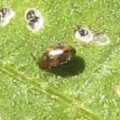Fast-growing and useful for both greens and the root crop; also very easy to grow.
Botanical Information
Taxonomy
| Kingdom: | Plantae |
| (unranked): | Angiosperms |
| (unranked): | Eudicots |
| (unranked): | Rosids |
| Order: | Brassicales |
| Family: | Brassicaceae |
| Genus: | Raphanus |
| Species: | R. sativus |
Part of the Cole Family (Brassicaceae), which includes broccoli, cabbage, cauliflower, kohlrabi, kale, collards, rutabaga, turnip, mustards.
History
Physical Description
Varieties & Cultivars
Categories or Types of [plantname]
Colors Available
Varieties (link to ../category/cultivars/tag/[plantname])
Growth Requirements
Climate & Temperature Requirements
Air Temperature
- considered a cool season crop, but happy in cool, warm, or hot weather
- temperature guidelines:
- minimum: 40°F
- optimal temperature range: 45°-90°F
- optimum temperature: 85°F
- maximum: 95°F
Soil Temperature
Humidity
Day Length or Light Requirements
Site Conditions Favored
Soil Requirements
Soil Texture
pH
Nutrient Requirements
Propagation
Methods of propagation
Seed
- start outdoors since they are such quick growers
- sow seeds in mid-summer and no later than early fall BG
Transplanting or Potting Up
- root crops don’t usually like to be transplanted
Seed Saving
Planting Out
Bed Prep & Soil Amendments
Bed Spacing
Row Spacing
Planting Depth
- 1/2″ BG
Alternative Bed Methods
- biointensive: 3″ equidistantly BG
Container Gardening
Routine Cultivation & Maintenance
Water Requirements
Fertilization Recommendations
Mulching & Weeding
Pinching or Pruning & Dividing
Support
Winterizing
Companion Planting
Helpful Companions
- Peas HGMV
- Nasturtiums: deters aphids, squash bugs, and striped pumpkin beetles; improves growth & flavor HGMV
- Lettuce HGMV
- Cucumbers HGMV
- Chervil: improves growth & flavor HGMV
Harmful Companions
- Hyssop: keep away from radishes HGMV
Companion to..
- Peas HGMV
- anything susceptible to striped cucumber beetles (radishes are thought to be helpful in controlling them) HGMV
Pests, Diseases & Problems
Common Pests
Common Diseases
Symptoms
Whole Plant
Leaves
Stem/Trunk
Flowers
Fruit
Roots
Harvesting & Storage
Edible Parts of the Plant
Yield
- biointensive:
- Neither weight nor area efficient HGMV
- 100 lbs per 100 sq ft for beginners
- 540 lbs per 100 sq ft for advanced
Days to Harvest / Harvest Timing
- days to maturity: 70-182 days BG
- matures in 17+ weeks BG
- harvest lasts for 4-8 weeks BG
- can succession sow & harvest easily with this quick-growing crop
- allow crop to mature over winter
- When radishes begin to mature you’ll see their shoulders rising above the soil; pull one up and check out the size; mature radishes will be about 1/2″ – 1 1/2″ in diameter VG
Harvest Methods
Storage of harvest
Fresh
Canned
Frozen
Pickled
Dried
Cooking
Nutritional Benefits & Values
Toxicity
Cooking
Preparation
Cooking Methods
Recipes (link to …/category/recipes/tag/[plantname])
Resources
Information for this article was taken from these sources:


